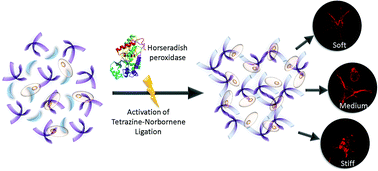Polyethylene glycol–gelatin hydrogels with tuneable stiffness prepared by horseradish peroxidase-activated tetrazine–norbornene ligation†
Abstract
Tetrazine–norbornene ligation has previously been applied in bioorthognal polymer crosslinking to form hydrogels suitable for 3D cell culture. However, the tetrazine group is prone to reduction by the free thiol in a biological environment, reducing the crosslinking efficiency and shortening the storage of tetrazine containing linkers. Here, we introduce a method to form a tetrazine group in situ by catalytic oxidation of the dihydrogen tetrazine using horse radish peroxidase (HRP). Enzymatic oxidation is highly efficient at a low HRP concentration and does not require hydrogen peroxide, allowing for rapid gelation when HRP was added to an aqueous solution of 4-arm PEG dihydrogentetrazine and gelatin norbornene. The storage modulus of the resultant gels can be varied by changing the concentration of the crosslinker, which is in the range of 1.2–3.8 kPa. Human mesenchymal stem cells encapsulated within these gels, with varying stiffness, display varied interactions and morphologies and can be maintained with prolonged culture periods of at least 32 days of 3D culture. The enzymatic activation of tetrazine–norbornene is therefore an attractive addition to the tetrazine ligation that is highly suitable for cell related studies in tissue engineering.



 Please wait while we load your content...
Please wait while we load your content...